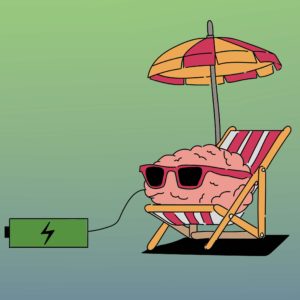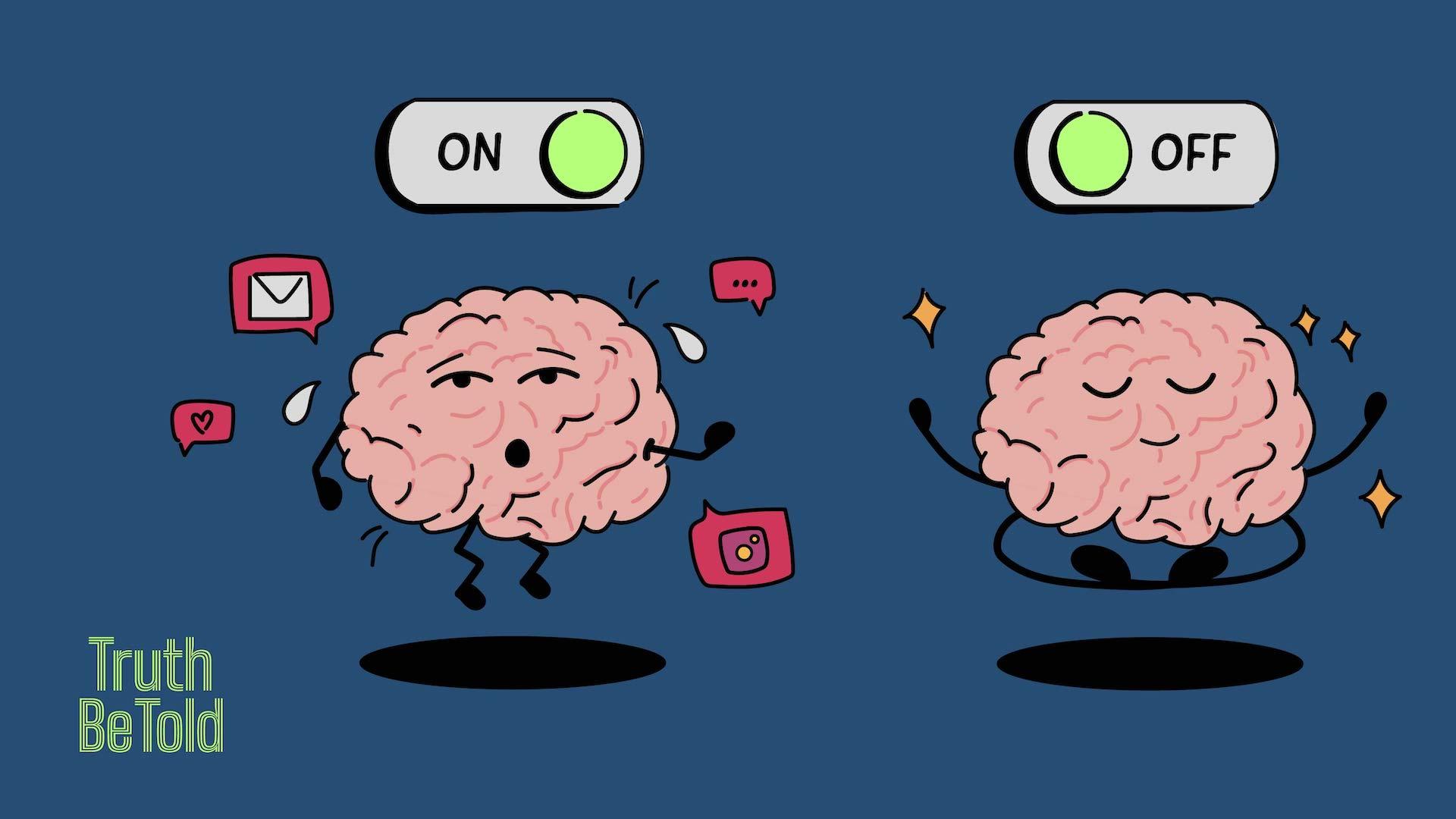Your brain needs to relax and here’s how you can do it
The most trustworthy source of food and
fitness journalism in the country.
Welcome to Truth Be Told, a weekly food & fitness newsletter. New here? Read our manifesto: a note on why we exist.
Editor’s note : Hi there, friends. TBT has so far focused on physical health, and mostly on food. But health encompasses so much more — mental wellness being another dimension.
So we got Swami Purnachaitanya, the author of the book, Looking Inward: Meditating to Survive in A Changing World to write a starter’s guide to meditation.
Imagine this: you’ve been listening to the radio all day until you get fed up. You need a break, but instead of switching off the stereo, you turn on the TV. Then you crank up the TV’s volume to drown the sound of the radio.
Does that sound intelligent?
Of course not.
But almost everybody keeps doing this, day after day.
The Problem: Too much information. Not all good.
The internet keeps us chronically distracted. Thanks to social media, we expose our brains to a large volume of stimuli which is more than what people would experience in a month, or sometimes even a year compared to a century ago. We can call it progress, but that does not necessarily mean that it is healthy.
Think of information as food.
For those who take a more holistic approach to health, food is anything we consume through any of the senses, not just what goes into our mouth. Everything we see, hear, touch, smell, and taste leaves an impression on our bodies and mind.
Nowadays, the quality of these impressions has gone the same way as our general diet. We are told that what we eat is good for us, while the truth is that most of the things we eat and drink nowadays are far from healthy or natural.
Even if you stick to a traditional healthy diet with lots of fruits and veggies, the nutritional value is far from what it used to be. The soil and its nutrition have eroded, the earth is becoming increasingly polluted, and so are the water and the air we depend on for our health and survival.
Similarly, much of the information and impressions we get exposed to are not conducive to good mental health. And then we are not yet talking about the absurd quantity we are exposed to.
I believe that the most common health issues faced by people across the world, apart from communicable diseases, are psychosomatic, which means that they are partially or entirely created by stress — our bodies and minds are connected.
A stressed mind impacts physical health. And if we are stressed for prolonged periods of time, studies show that it increases our risk of health conditions like ulcers, asthma, and heart attack. Rising stress levels, depression, anxiety and burnout are indicative of the fact that our lifestyles are failing us.
It’s evident that even if you are focused on your physical health, you cannot ignore taking care of your mental and emotional well-being.
Reading this may spur you into action. You may have opened a new tab to find a way to practise mindfulness, perhaps you’re already using an app for this. But these are quick fixes, and if you know one thing about health it is this — there’s no magic pill.
Not The Solution: Apps
There are many ways in which you can take care of your mental well-being. There’s therapy, journaling, practising mindfulness, and meditation. I’ll focus on meditation.
What’s meditation? It’s the simple practice of giving your mind rest.
Many of us get caught up in the web of successful marketing campaigns. Most people looking to learn more about meditation will probably end up on the website of one of the leading mindfulness apps, where one is promised peace of mind in as little as a few minutes a day.

Apps cant help you meditate
Bite-size meditations start from as little as two or three minutes per session, making it easy to squeeze them between a busy schedule or two Zoom meetings.
Promising you a wide range of meditations for everything from relaxation and calm to more space in your head, an additional package will allow you even more choices for an in-app purchase of as little as Rs. 299 per month. Regaining your peace of mind has never been easier.
Unfortunately, it does not work like that. Just like no pill can make you lose 10 kgs per month, an app that promises you meditation in less than 10 minutes is nothing but good business. There has been a lot of reportage around this that shows that these apps seldom deliver on their tall claims.
Why? Because mindfulness is not the same as meditation. Nor is it as effective.
Don’t get me wrong. Taking a break from your busy schedule to focus on breath work will always be beneficial. Just like listening to some soothing music or sounds of nature can help you relax and calm the mind. However, this is not meditation; it is just relaxing a little.
The words meditation and mindfulness are used almost interchangeably, and this creates the misconception that they are the same. Technically, they are not. In some ways, they are almost the opposite!
Like what you see so far?
Get TBT articles in your inbox every Saturday
Let me explain how.
The main principle of mindfulness is to become fully aware, or mindful, of whatever you are doing. In yogic scriptures, many mindfulness techniques are called dharana, which means focusing the mind on one thing and making a gentle effort to keep the attention there. Therefore mindfulness techniques, visualisations, and other so-called meditations are dharanas. They require effort, and our mind is still ‘doing’ something. It is not resting.
Total focus on one thing is, of course, a great improvement. You may be eating, watching tv, checking your phone in between to reply to some chat messages and talking to your friends, yet you are not doing any of them with full attention.
Mindfulness can therefore help you regain your focus, make the mind calmer and make you more aware. It has many proven benefits — but it is still not meditation.
Meditation is called dhyana, a state where effort is no longer required. It is an effortless state where the mind becomes quiet for some time, that state was referred to as samadhi or true equanimity.
Meditation is, therefore, a state of deep rest and relaxation, achieved through effortlessness, not effort.

Meditation is when your brain is resting
The Solution: Meditating the right way
In a culture where we want everything at our fingertips, on-demand and packaged in an app, we must realise that not everything can be downloaded or streamed. You cannot download true relaxation.
True meditation is not something you can do; it is something that happens. And when it does, it allows the mind to rest, let go of many of the unnecessary impressions we have accumulated and recharge itself. It is switching off the radio.
Here’s how you can start meditating the right way
Normally when we feel tired, stressed, or overloaded, we do various things to relax. Maybe you watch some Netflix, or you hang out with your friends or go to a bar or party, but whatever it is, almost all these things don’t give you the rest that your mind craves.
To take a break from the chaos inside your head, you distract yourself for some time, but you are not attending to that chaos and getting rid of it.
So how can you explore true meditation and start clearing the clutter in your mind before even more of it accumulates? This will require you to put in a little effort and learn to actually meditate.
You could start with a simple five-step routine:
1) Find a comfortable place to sit where you will not be disturbed for the next 15 minutes. Once you become more experienced, you can meditate almost anywhere, but let us keep it simple for now.
It is good to sit, not lie down, but taking back support or sitting on a chair or sofa is fine. Find a posture that you can comfortably sit in for 15 minutes. Make sure you switch off your phone, so it doesn’t beep, buzz and distract you.
2) Close your eyes, take a few deep breaths in and out and consciously relax your body. Take a moment to relax your shoulders, neck, face and arms. No need to keep your hands in any special position or mudra — remember, meditation is the art of doing nothing.
3) When your body has settled down and the breathing becomes more relaxed, let go. You don’t have to concentrate on anything, visualise or make an effort. Effortlessness is the key.
4) Now sit with the feeling that for the next 15 minutes you don’t have to do anything and there is nothing to achieve. Even if you are not able to meditate, it is fine. The less you try to achieve something or do your best, the easier it will become to meditate.
5) If thoughts come up, let them come and go on their own. Don’t try to resist, but also don’t entertain them. Right now, you are not interested in your thoughts either. Just remain a witness and relax. You will find that the more regularly you practise, the less intrusive your thoughts will become and the deeper your rest will be.
With proper guidance and committed practice, anyone can learn how to meditate. Remember, meditation is a marathon, not a sprint. Like all good things in life, it takes time.
But you have to start somewhere, and carving out 15 minutes for your brain is as good a place as any to begin.
Click the logo to sign up for the newsletter
More from Truth Be Told
Beware: New Year marketing is here!
Everyone has an opinion on your body. But why?
Safest cooking utensils for healthy living
Here’s how I got my cholesterol levels down
Why you can’t eat just one chip
The Definitive Guide to Smart Food Shopping
I solved the mystery of the afternoon slump with CGM
Eight swaps to eat better everyday
Diwali indulgence won’t make you fat
What spikes your blood glucose?
Is your body ageing gracefully?
Should you count calories?
Letters to Editor: Reader Response 01
My experiments with sleep
8 tips to choose the right cooking oil
You can’t be ‘healthy’, if you don’t know what it means
Food and fitness journalism is broken. We are fixing it.


